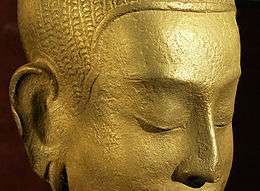Seven Factors of Awakening
In Buddhism, the Seven Factors of Awakening (Pali: satta bojjhaṅgā or satta sambojjhaṅgā; Skt.: sapta bodhyanga) are:
- Mindfulness (sati, Sanskrit smrti). To maintain awareness of reality (dharma).
- Investigation of the nature of reality (dhamma vicaya, Skt. dharmapravicaya).
- Energy (viriya, Skt. vīrya) also determination, effort
- Joy or rapture (pīti, Skt. prīti)
- Relaxation or tranquility (passaddhi, Skt. prashrabdhi) of both body and mind
- Concentration, (samādhi) a calm, one-pointed state of mind,[1] or clear awareness
- Equanimity (upekkha, Skt. upekshā). To accept reality as-it-is (yathā-bhuta) without craving or aversion.

| Part of a series on |
| Buddhism |
|---|
 |
|
|
|
| 37 DHAMMĀ of ENLIGHTENMENT |
4 Efforts |
4 Bases |
|||||||||||||||||
|---|---|---|---|---|---|---|---|---|---|---|---|---|---|---|---|---|---|---|---|
| 5 Faculties |
5 Powers | ||||||||||||||||||
| 7 Factors |
|||||||||||||||||||
| 8 Path Factors |
|||||||||||||||||||
 | |||||||||||||||||||
This evaluation of seven awakening factors is one of the "Seven Sets" of "Awakening-related states" (bodhipakkhiyadhamma).
The Pali word bojjhanga is a compound of bodhi ("awakening," "enlightenment") and anga ("factor").[2]
Etymology
Satta sambojjhaṅgā:
Pali literature
In the Sutta Pitaka's Samyutta Nikaya, the bojjhangas refer to wholesome, mundane factors leading to enlightenment. In the Abhidhamma and Pali commentaries, the bojjhangas tend to refer to supramundane factors concurrent with enlightenment.[4]
Sutta Pitaka
According to one discourse in the Samyutta Nikaya entitled "Bhikkhu Sutta" (SN 46.5):
- [Bhikkhu:] "Venerable sir, it is said, 'factors of enlightenment, factors of enlightenment.' In what sense are they called factors of enlightenment?"
- [Buddha:] "They lead to enlightenment, bhikkhu, therefore they are called factors of enlightenment...."[5]
During meditation, one may contemplate the seven Factors of Enlightenment as well as on their antithesis, the Five Hindrances (sensual pleasure, ill-will, sloth-torpor, restlessness-worry, doubt).[6] In addition, one Samyutta Nikaya sutta identifies developing each of the enlightenment factors accompanied by each of the four brahma viharas (lovingkindness, compassion, sympathetic joy, equanimity).[7]
In the Samyutta Nikaya's "Fire Discourse," the Buddha identifies that mindfulness is "always useful" (sabbatthika); while, when one's mind is sluggish, one should develop the enlightenment factors of investigation, energy and joy; and, when one's mind is excited, one should develop the enlightenment factors of tranquility, concentration and equanimity.[8]
Again according to the Samyutta Nikaya, once when the Buddha was gravely ill he asked Venerable Mahacunda to recite the seven Factors of Enlightenment to him. In such a way the Buddha was cured of his illness.[9]
Abhidhamma and commentarial literature
In the Visuddhimagga, in a section discussing skills needed for the attainment and maintenance of absorption (jhana), Buddhaghosa identifies the bojjhangas in the following fashion:
- "Strong mindfulness ... is needed in all instances...."
- "When his mind is slack with over-laxness of energy, etc., then ... he should develop those [three enlightenment factors] beginning with investigation-of-states..." (i.e., dhamma vicaya, viriya, piti).
- "When his mind is agitated through over-energeticness, etc., then ... he should develop those [three enlightenment factors] beginning with tranquility..." (i.e., passaddhi, samadhi, upekkha).[10]
Meditation
| Balancing enlightenment factors & hindrances | |
|
to be used when experiencing sloth & torpor (thīna-middha) to regain mindfulness |
|
the balancing factor |
|
to be used when experiencing restlessness & worry (uddhacca-kukkucca) to regain mindfulness |
The seven factors of awakening are closely related to the practice of dhyana, resembling the various factors that are part of the four dhyanas.[11]
In meditation everyone most likely experiences two of the five hindrances (Pāli: pañca nīvaraṇāni). They are sloth and torpor (Pāli: thīna-middha), which is half-hearted action with little or no collectedness, and restlessness and worry (uddhacca-kukkucca), which is the inability to calm the mind.
As indicated above, in the "Fire Discourse" (SN 46.53), it is recommended that joy or rapture, investigation, and energy are to be developed when experiencing sloth and torpor. Relaxation, concentration, and equanimity are to be developed when experiencing restlessness or worry. Mindfulness should be constantly present to remain aware of physical change as well as mental change in either skillful or unskillful direction.[8]
See also
Notes
- See, e.g., Rhys Davids & Stede (1921-25), entry for "Samādhi," retrieved 3 Feb. 2011 from "U.Chicago" at "Archived copy". Archived from the original on 2012-07-09. Retrieved 2012-08-17.CS1 maint: archived copy as title (link) .
- For instance, see Rhys Davids & Stede (1921-25), p. 490, entry for "Bojjhanga" (retrieved 10 Jul 2007).
- Critical Pali Dictionary, aṅga
- Bodhi (2000), p. 1499.
- Bhikkhu Sutta (SN 46.5), trans. Bodhi (2000), p. 1574. See also Walshe (1985), n. 265.
- For an example of a discourse that includes the juxtaposition of these two sets of phenomena, see the Satipatthana Sutta. For a group of discourses in which these two sets of phenomena are juxtaposed, see SN 46.31 to 46.40 (Bodhi, 2000, pp. 1501, 1589-94).
- SN 46.54, variously known as the Mettaasahagata Sutta (CSCD) or Metta Sutta (SLTP) or Metta.m Sutta (PTS Feer). See Bodhi (2000), pp. 1607-11; Walshe (1985), sutta 59, pp. 71-73.
- "Fire Discourse" (Aggi Sutta, SN 46.53) (Bodhi, 2000, pp. 1605-7; Walshe, 1985, sutta 58, pp. 69-70).
- Gilana Sutta (SN 46.16) (Piyadassi, 1999; Piyadassi, n.d.).
- Buddhaghosa & Ñāṇamoli (1999), pp. 129, 131. Note that Buddhaghosa clearly references the last six bojjhangas in the last two cited statements. The first statement about sati (mindfulness), while immediately preceding mention of the bojjhangas, is technically in reference to the five spiritual faculties (indriya). See also SN 46.53 (Bodhi, 2000, pp. 1605-7; Walshe, 1985, sutta 58, pp. 69-70).
- Gethin, Tha Buddhis Path to Awakening, chapter five; Arbel (2017), Early Buddhist Meditation
Sources
- Bodhi, Bhikkhu (trans.) (2000). The Connected Discourses of the Buddha: A Translation of the Samyutta Nikaya. Boston: Wisdom Pubs. ISBN 0-86171-331-1.
- Buddhaghosa, Bhadantacariya & Bhikkhu Ñāṇamoli (trans.) (1999). The Path of Purification: Visuddhimagga. Seattle, WA: BPS Pariyatti Editions. ISBN 1-928706-00-2.
- Piyadassi Thera, Venerable (trans.) (1999). Gilana Sutta: Ill (Factors of Enlightenment) (SN 46.16). Retrieved 10 Jul 2007 from "Access to Insight" at http://www.accesstoinsight.org/tipitaka/sn/sn46/sn46.016.piya.html.
- Piyadassi Thera, Venerable (trans.) (n.d.). The Book of Protection: Factors of Enlightenment (3), Maha Cunda Thera Bojjhanga. Retrieved from "BuddhaNet.net" at http://www.buddhanet.net/e-learning/buddhism/bp_sut14.htm.
- Rhys Davids, T.W. & William Stede (eds.) (1921-5). The Pali Text Society's Pali–English Dictionary. Chipstead: Pali Text Society. A general on-line search engine for this dictionary is available at http://dsal.uchicago.edu/dictionaries/pali/.
- Walshe, Maurice O'C. (1985). Samyutta Nikaya: An Anthology (Part III) (Wheel No. 318-321). Kandy: Buddhist Publication Society. Retrieved 2008-11-09 from "Access to Insight" (2007, 2009) at http://www.accesstoinsight.org/lib/authors/walshe/wheel318.html and, for an excerpted version of the "Fire Discourse" (SN 46.53), at http://www.accesstoinsight.org/tipitaka/sn/sn46/sn46.053.wlsh.html .
External links
- Thanissaro Bhikkhu (trans.) (1997). Himavanta Sutta: The Himalayas (On the Factors for Awakening) (SN 46.1). Retrieved from "Access to Insight" at http://www.accesstoinsight.org/canon/sutta/samyutta/sn46-001.html.
- Seven Factors of Enlightenment by Ven Vimalaramsi
- The Seven Factors of Enlightenment by Ven Piyadassi
- The Seven Factors of Enlightenment by Ven Ariyadhamma